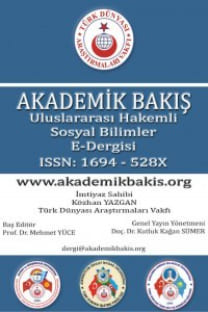ÜNİVERSİTELİ ÖĞRENCİLERDE DİNDARLIĞI ETKİLEYEN BAZI FAKTÖRLER
.Bu araştırmanın temel amacı üniversitesi öğrencilerinin dinsel yaşantı biçimlerini (dindarlık
boyutları: inanç, ibadet, etki) bazı sosyo- kültürel ve demografik değişkenler açısından
incelemektir. Bu bağlamda araştırma evrenini Bursa Uludağ Üniversitesi ve Çanakkale On
sekiz Mart Üniversitesi’nde öğrenim gören öğrenciler, örneklemini ise söz konusu
üniversitelerin değişik fakülte ve bölümlerinde öğrenim gören 632 kız ve erkek öğrenci teşkil
etmektedir. Örneklem tarama yöntemi ve anket tekniği kullanılarak gerçekleştirilen
araştırmada veri toplama aracı olarak “kişisel bilgi formu” ve “dindarlık ölçeği”
kullanılmıştır.
Araştırma sonucunda, üniversiteli öğrencilerin fakültelerine, cinsiyetlerine, gelir durumlarına,
annelerinin eğitim durumlarına, din eğitimi alıp-almama durumlarına, din eğitimi aldıkları
yere ve ailelerinin dindarlık düzeylerine göre dindarlık boyutlarındaki ortalamalarında
anlamlılık düzeyinde farklılaşmalar ve ilişkiler (korelasyonlar) olduğu gözlenmiştir. Buna
karşılık söz konusu öğrencilerin sınıflarına, yaşlarına ve babalarının eğitim düzeylerine göre
dinî inanç, dinî ibadet ve dinî etki boyutlarındaki puan ortalamalarında anlamlılık düzeyinde
farklılaşmalar ve babanın eğitim durumu hariç anlamlılık düzeyinde ilişkiler (korelasyon)
olmadığı gözlenmiştir
Anahtar Kelimeler:
Dindarlık, sosyo-kültürel ve demografik değişkenler
SOME FACTORS THAT AFFECT RELIGIOSITY IN UNIVERSITY STUDENTS
The main purpose of the present study is to examine the religious lifestyles (religiosity
dimensions: faith, religious prayer, influence) of university students in terms of some sociocultural
and demographic variables. In this context the population of the study is constituted
by the students attending to the Bursa Uludag University and Canakkale Onsekiz Mart
University, while the sample was constituted by a total of 632 female and male students
attending to the various faculties and departments of these two universities. In the study that
was carried out with sample scanning method and questionnaire technique, a "personal
information form" and the "religiosity scale" were used as the data collection tools.
In consequence of the study it is determined that there were significant levels of differences
and relations (correlations) in university students' religiosity dimension averages according to
the faculties they attend to, their genders, income levels, educational levels of their mothers,
whether or not they received religious education, the place they received religious education
and the religiosity levels of their families. On the other hand it was determined that no
significant differences and relations (correlations) exist in the point averages the students
scored in the religious faith, religious prayer and religious influence dimensions on the basis
of the students' classes, ages and their fathers' educational background. But only it is
determined that there was a significant level of relation (correlation) in university students'
religiosity dimension averages according to educational levels of their fathers.
Keywords:
socio-cultural and demographic variables,
- Başlangıç: 2004
- Yayıncı: Akademik Bakış
Sayıdaki Diğer Makaleler
Şirvan Şen DEMİR, Betül YEŞİLTEPE, Mahmut DEMİR
KLASİK TÜRK EDEBİYATINDA BABADAN OĞULA-EBEVEYNDEN ÇOCUĞA-NASİHAT GELENEĞİ
İRAN'DA RADYO YAYINCILIĞI: DİNLEYİCİLER ÜZERİNE BİR ARAŞTIRMA
TÜRKİYEDE YİTİRİLEN BİR İKTİSADİ FAALİYET: SÜNGERCİLİK
Altan AYAN, Agah Sinan ÜNSAR, Mustafa Deniz DİNDAR
BİR İLETİŞİM ARACI OLARAK SİNEMA FİLMLERİNDE DİNİ İDEOLOJİNİN KULLANIMI: TAKVA
Kamil KANIPEK, İsmail BALIKÇIOĞLU
TÜRKİYE TÜRKÇESİNDEKİ TÜREMİŞ KÖK FİİLLERİN YAPI VE ANLAM ÖZELLİKLERİ
ÜNİVERSİTELİ ÖĞRENCİLERDE DİNDARLIĞI ETKİLEYEN BAZI FAKTÖRLER
